Business Strategy Report: Uber's Macro and Micro Environment
VerifiedAdded on 2022/12/28
|17
|4737
|32
Report
AI Summary
This report provides a comprehensive analysis of Uber's business strategy. It begins by examining the impact of the macro-environment on Uber, utilizing PESTEL analysis to assess political, economic, social, technological, and legal factors, and stakeholder analysis to understand key relationships. The report then delves into Uber's internal environment, applying VRIO analysis to evaluate its resources and capabilities, and the McKinsey 7S framework to assess organizational effectiveness. Furthermore, the report applies Porter's Five Forces to analyze the competitive landscape, and the balanced scorecard to assess performance. Finally, the report discusses theories and concepts that inform Uber's strategic planning. The report concludes with a summary of the findings and recommendations.
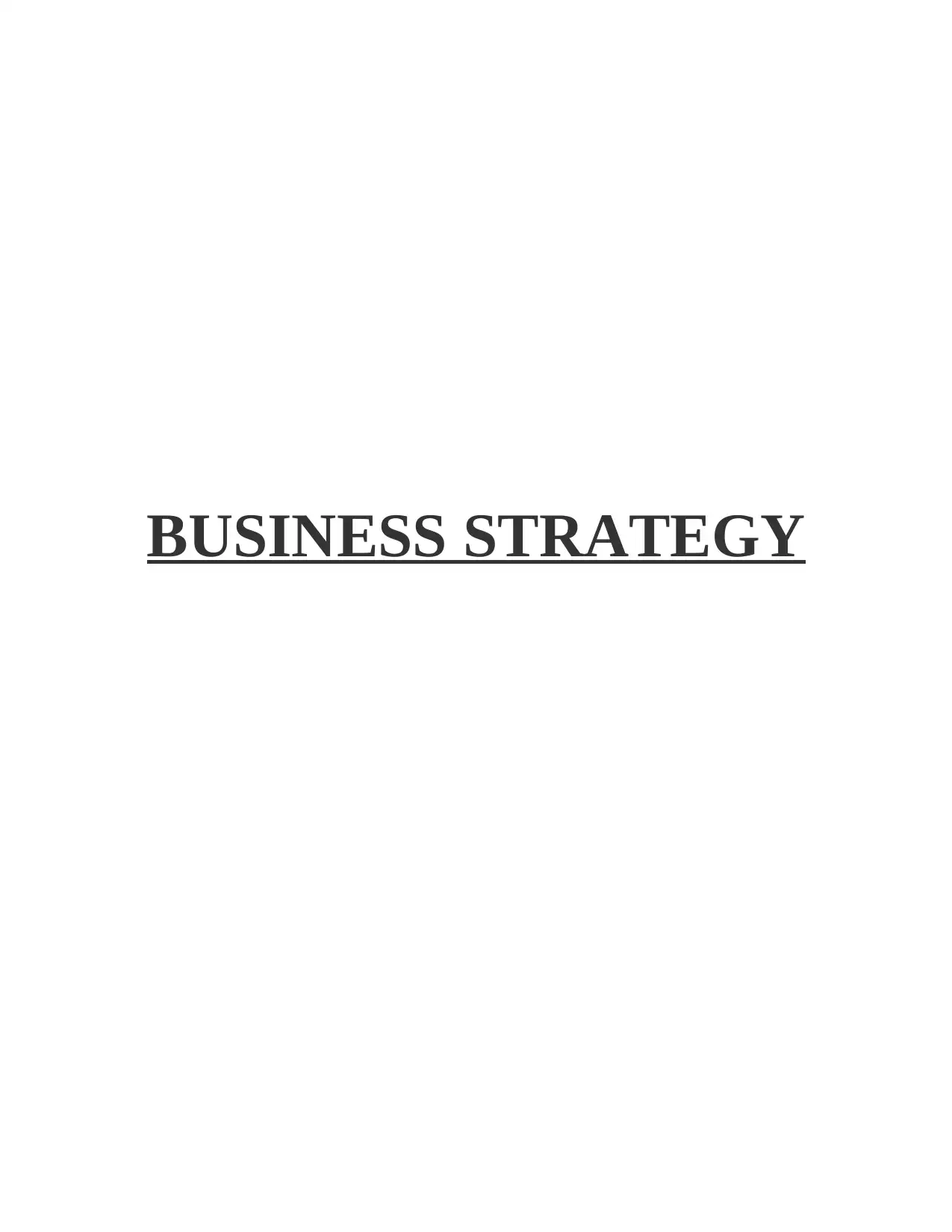
BUSINESS STRATEGY
Paraphrase This Document
Need a fresh take? Get an instant paraphrase of this document with our AI Paraphraser
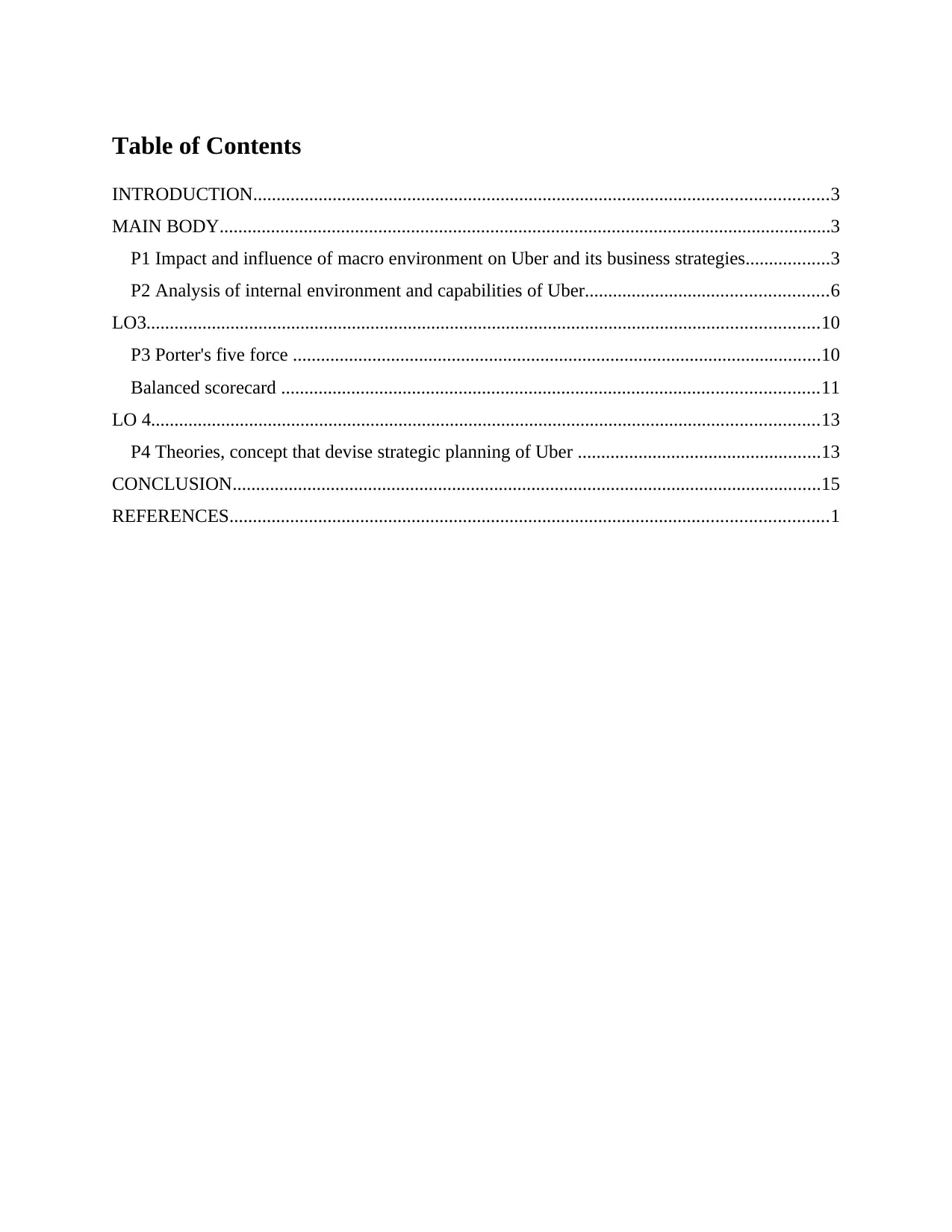
Table of Contents
INTRODUCTION...........................................................................................................................3
MAIN BODY...................................................................................................................................3
P1 Impact and influence of macro environment on Uber and its business strategies..................3
P2 Analysis of internal environment and capabilities of Uber....................................................6
LO3................................................................................................................................................10
P3 Porter's five force .................................................................................................................10
Balanced scorecard ...................................................................................................................11
LO 4...............................................................................................................................................13
P4 Theories, concept that devise strategic planning of Uber ....................................................13
CONCLUSION..............................................................................................................................15
REFERENCES................................................................................................................................1
INTRODUCTION...........................................................................................................................3
MAIN BODY...................................................................................................................................3
P1 Impact and influence of macro environment on Uber and its business strategies..................3
P2 Analysis of internal environment and capabilities of Uber....................................................6
LO3................................................................................................................................................10
P3 Porter's five force .................................................................................................................10
Balanced scorecard ...................................................................................................................11
LO 4...............................................................................................................................................13
P4 Theories, concept that devise strategic planning of Uber ....................................................13
CONCLUSION..............................................................................................................................15
REFERENCES................................................................................................................................1
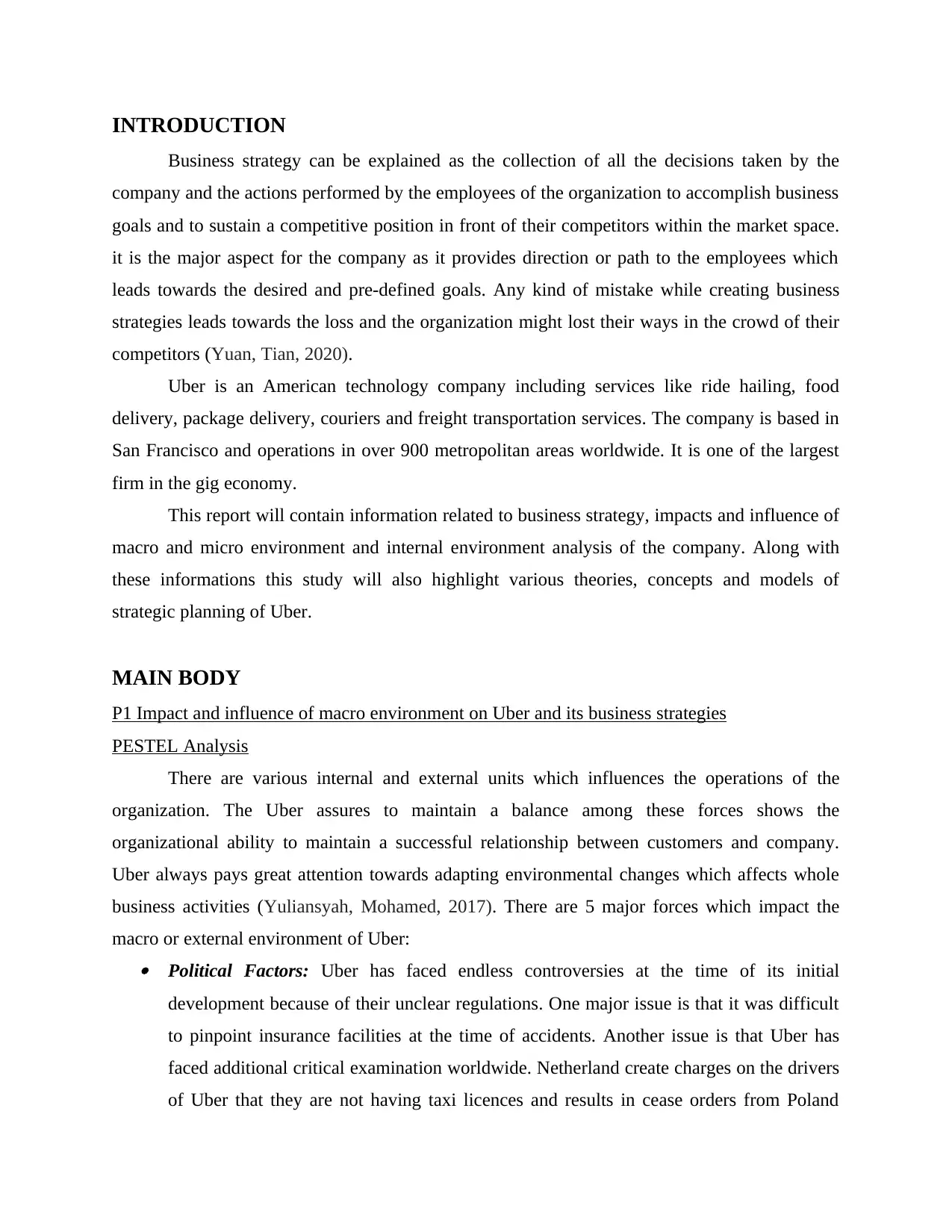
INTRODUCTION
Business strategy can be explained as the collection of all the decisions taken by the
company and the actions performed by the employees of the organization to accomplish business
goals and to sustain a competitive position in front of their competitors within the market space.
it is the major aspect for the company as it provides direction or path to the employees which
leads towards the desired and pre-defined goals. Any kind of mistake while creating business
strategies leads towards the loss and the organization might lost their ways in the crowd of their
competitors (Yuan, Tian, 2020).
Uber is an American technology company including services like ride hailing, food
delivery, package delivery, couriers and freight transportation services. The company is based in
San Francisco and operations in over 900 metropolitan areas worldwide. It is one of the largest
firm in the gig economy.
This report will contain information related to business strategy, impacts and influence of
macro and micro environment and internal environment analysis of the company. Along with
these informations this study will also highlight various theories, concepts and models of
strategic planning of Uber.
MAIN BODY
P1 Impact and influence of macro environment on Uber and its business strategies
PESTEL Analysis
There are various internal and external units which influences the operations of the
organization. The Uber assures to maintain a balance among these forces shows the
organizational ability to maintain a successful relationship between customers and company.
Uber always pays great attention towards adapting environmental changes which affects whole
business activities (Yuliansyah, Mohamed, 2017). There are 5 major forces which impact the
macro or external environment of Uber: Political Factors: Uber has faced endless controversies at the time of its initial
development because of their unclear regulations. One major issue is that it was difficult
to pinpoint insurance facilities at the time of accidents. Another issue is that Uber has
faced additional critical examination worldwide. Netherland create charges on the drivers
of Uber that they are not having taxi licences and results in cease orders from Poland
Business strategy can be explained as the collection of all the decisions taken by the
company and the actions performed by the employees of the organization to accomplish business
goals and to sustain a competitive position in front of their competitors within the market space.
it is the major aspect for the company as it provides direction or path to the employees which
leads towards the desired and pre-defined goals. Any kind of mistake while creating business
strategies leads towards the loss and the organization might lost their ways in the crowd of their
competitors (Yuan, Tian, 2020).
Uber is an American technology company including services like ride hailing, food
delivery, package delivery, couriers and freight transportation services. The company is based in
San Francisco and operations in over 900 metropolitan areas worldwide. It is one of the largest
firm in the gig economy.
This report will contain information related to business strategy, impacts and influence of
macro and micro environment and internal environment analysis of the company. Along with
these informations this study will also highlight various theories, concepts and models of
strategic planning of Uber.
MAIN BODY
P1 Impact and influence of macro environment on Uber and its business strategies
PESTEL Analysis
There are various internal and external units which influences the operations of the
organization. The Uber assures to maintain a balance among these forces shows the
organizational ability to maintain a successful relationship between customers and company.
Uber always pays great attention towards adapting environmental changes which affects whole
business activities (Yuliansyah, Mohamed, 2017). There are 5 major forces which impact the
macro or external environment of Uber: Political Factors: Uber has faced endless controversies at the time of its initial
development because of their unclear regulations. One major issue is that it was difficult
to pinpoint insurance facilities at the time of accidents. Another issue is that Uber has
faced additional critical examination worldwide. Netherland create charges on the drivers
of Uber that they are not having taxi licences and results in cease orders from Poland
⊘ This is a preview!⊘
Do you want full access?
Subscribe today to unlock all pages.

Trusted by 1+ million students worldwide
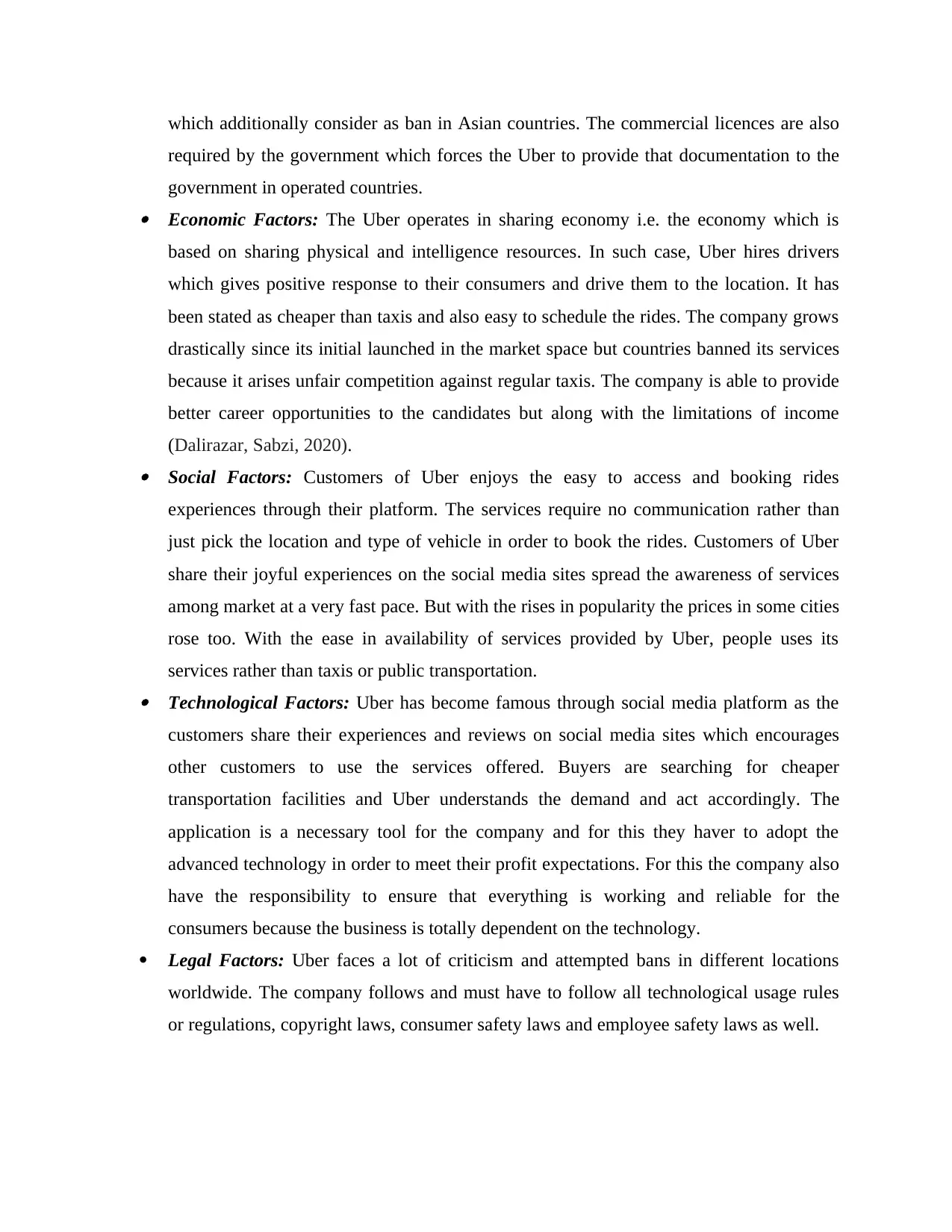
which additionally consider as ban in Asian countries. The commercial licences are also
required by the government which forces the Uber to provide that documentation to the
government in operated countries. Economic Factors: The Uber operates in sharing economy i.e. the economy which is
based on sharing physical and intelligence resources. In such case, Uber hires drivers
which gives positive response to their consumers and drive them to the location. It has
been stated as cheaper than taxis and also easy to schedule the rides. The company grows
drastically since its initial launched in the market space but countries banned its services
because it arises unfair competition against regular taxis. The company is able to provide
better career opportunities to the candidates but along with the limitations of income
(Dalirazar, Sabzi, 2020). Social Factors: Customers of Uber enjoys the easy to access and booking rides
experiences through their platform. The services require no communication rather than
just pick the location and type of vehicle in order to book the rides. Customers of Uber
share their joyful experiences on the social media sites spread the awareness of services
among market at a very fast pace. But with the rises in popularity the prices in some cities
rose too. With the ease in availability of services provided by Uber, people uses its
services rather than taxis or public transportation. Technological Factors: Uber has become famous through social media platform as the
customers share their experiences and reviews on social media sites which encourages
other customers to use the services offered. Buyers are searching for cheaper
transportation facilities and Uber understands the demand and act accordingly. The
application is a necessary tool for the company and for this they haver to adopt the
advanced technology in order to meet their profit expectations. For this the company also
have the responsibility to ensure that everything is working and reliable for the
consumers because the business is totally dependent on the technology.
Legal Factors: Uber faces a lot of criticism and attempted bans in different locations
worldwide. The company follows and must have to follow all technological usage rules
or regulations, copyright laws, consumer safety laws and employee safety laws as well.
required by the government which forces the Uber to provide that documentation to the
government in operated countries. Economic Factors: The Uber operates in sharing economy i.e. the economy which is
based on sharing physical and intelligence resources. In such case, Uber hires drivers
which gives positive response to their consumers and drive them to the location. It has
been stated as cheaper than taxis and also easy to schedule the rides. The company grows
drastically since its initial launched in the market space but countries banned its services
because it arises unfair competition against regular taxis. The company is able to provide
better career opportunities to the candidates but along with the limitations of income
(Dalirazar, Sabzi, 2020). Social Factors: Customers of Uber enjoys the easy to access and booking rides
experiences through their platform. The services require no communication rather than
just pick the location and type of vehicle in order to book the rides. Customers of Uber
share their joyful experiences on the social media sites spread the awareness of services
among market at a very fast pace. But with the rises in popularity the prices in some cities
rose too. With the ease in availability of services provided by Uber, people uses its
services rather than taxis or public transportation. Technological Factors: Uber has become famous through social media platform as the
customers share their experiences and reviews on social media sites which encourages
other customers to use the services offered. Buyers are searching for cheaper
transportation facilities and Uber understands the demand and act accordingly. The
application is a necessary tool for the company and for this they haver to adopt the
advanced technology in order to meet their profit expectations. For this the company also
have the responsibility to ensure that everything is working and reliable for the
consumers because the business is totally dependent on the technology.
Legal Factors: Uber faces a lot of criticism and attempted bans in different locations
worldwide. The company follows and must have to follow all technological usage rules
or regulations, copyright laws, consumer safety laws and employee safety laws as well.
Paraphrase This Document
Need a fresh take? Get an instant paraphrase of this document with our AI Paraphraser
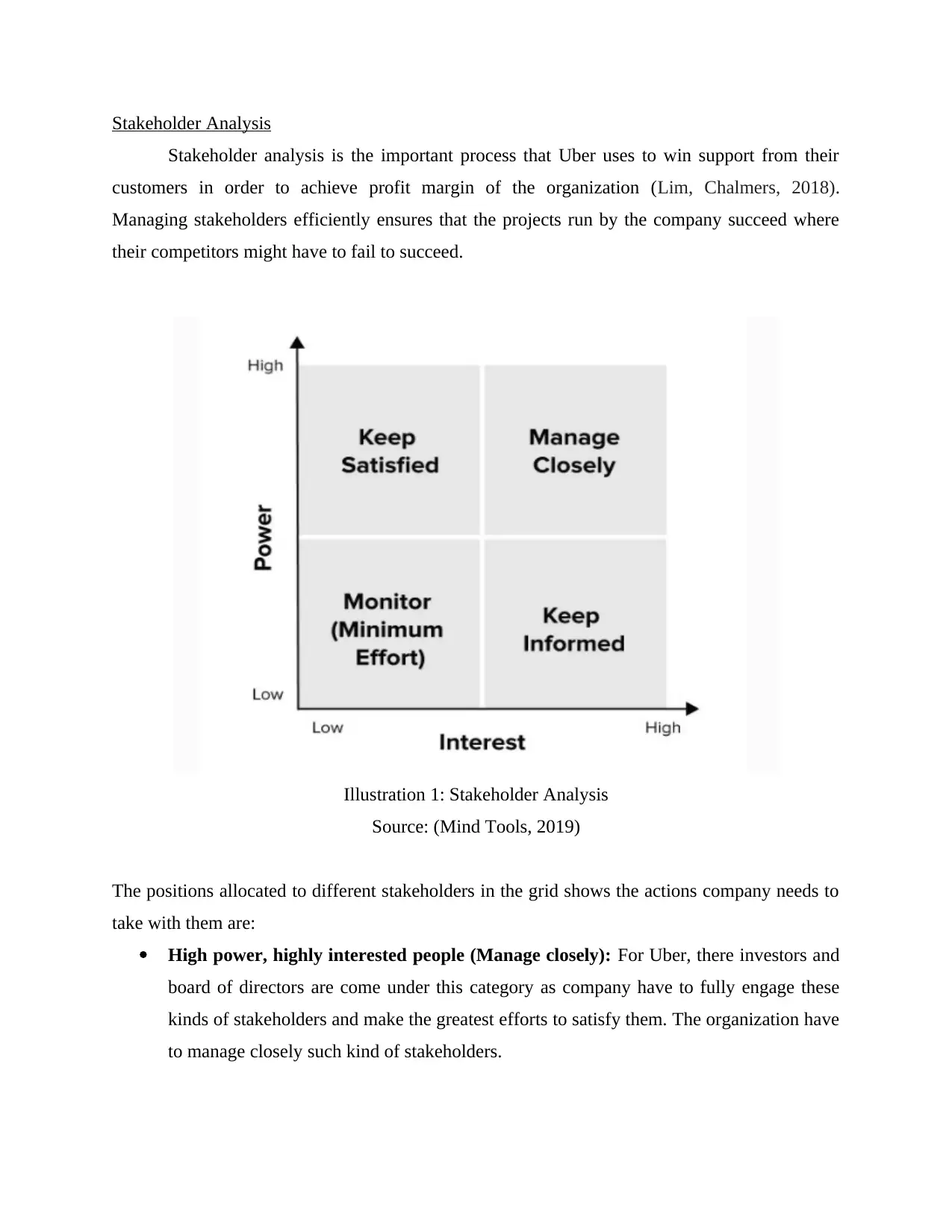
Stakeholder Analysis
Stakeholder analysis is the important process that Uber uses to win support from their
customers in order to achieve profit margin of the organization (Lim, Chalmers, 2018).
Managing stakeholders efficiently ensures that the projects run by the company succeed where
their competitors might have to fail to succeed.
The positions allocated to different stakeholders in the grid shows the actions company needs to
take with them are:
High power, highly interested people (Manage closely): For Uber, there investors and
board of directors are come under this category as company have to fully engage these
kinds of stakeholders and make the greatest efforts to satisfy them. The organization have
to manage closely such kind of stakeholders.
Illustration 1: Stakeholder Analysis
Source: (Mind Tools, 2019)
Stakeholder analysis is the important process that Uber uses to win support from their
customers in order to achieve profit margin of the organization (Lim, Chalmers, 2018).
Managing stakeholders efficiently ensures that the projects run by the company succeed where
their competitors might have to fail to succeed.
The positions allocated to different stakeholders in the grid shows the actions company needs to
take with them are:
High power, highly interested people (Manage closely): For Uber, there investors and
board of directors are come under this category as company have to fully engage these
kinds of stakeholders and make the greatest efforts to satisfy them. The organization have
to manage closely such kind of stakeholders.
Illustration 1: Stakeholder Analysis
Source: (Mind Tools, 2019)
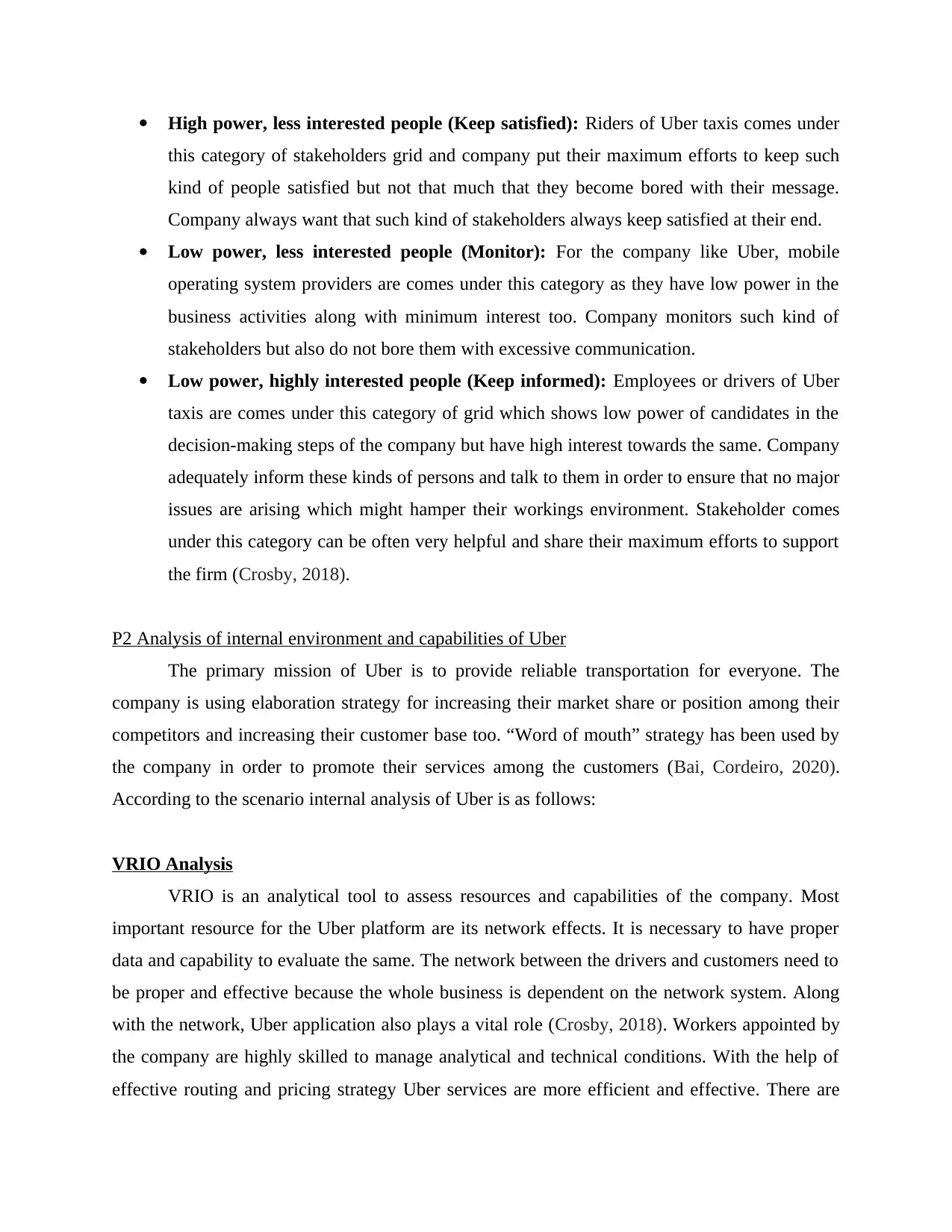
High power, less interested people (Keep satisfied): Riders of Uber taxis comes under
this category of stakeholders grid and company put their maximum efforts to keep such
kind of people satisfied but not that much that they become bored with their message.
Company always want that such kind of stakeholders always keep satisfied at their end.
Low power, less interested people (Monitor): For the company like Uber, mobile
operating system providers are comes under this category as they have low power in the
business activities along with minimum interest too. Company monitors such kind of
stakeholders but also do not bore them with excessive communication.
Low power, highly interested people (Keep informed): Employees or drivers of Uber
taxis are comes under this category of grid which shows low power of candidates in the
decision-making steps of the company but have high interest towards the same. Company
adequately inform these kinds of persons and talk to them in order to ensure that no major
issues are arising which might hamper their workings environment. Stakeholder comes
under this category can be often very helpful and share their maximum efforts to support
the firm (Crosby, 2018).
P2 Analysis of internal environment and capabilities of Uber
The primary mission of Uber is to provide reliable transportation for everyone. The
company is using elaboration strategy for increasing their market share or position among their
competitors and increasing their customer base too. “Word of mouth” strategy has been used by
the company in order to promote their services among the customers (Bai, Cordeiro, 2020).
According to the scenario internal analysis of Uber is as follows:
VRIO Analysis
VRIO is an analytical tool to assess resources and capabilities of the company. Most
important resource for the Uber platform are its network effects. It is necessary to have proper
data and capability to evaluate the same. The network between the drivers and customers need to
be proper and effective because the whole business is dependent on the network system. Along
with the network, Uber application also plays a vital role (Crosby, 2018). Workers appointed by
the company are highly skilled to manage analytical and technical conditions. With the help of
effective routing and pricing strategy Uber services are more efficient and effective. There are
this category of stakeholders grid and company put their maximum efforts to keep such
kind of people satisfied but not that much that they become bored with their message.
Company always want that such kind of stakeholders always keep satisfied at their end.
Low power, less interested people (Monitor): For the company like Uber, mobile
operating system providers are comes under this category as they have low power in the
business activities along with minimum interest too. Company monitors such kind of
stakeholders but also do not bore them with excessive communication.
Low power, highly interested people (Keep informed): Employees or drivers of Uber
taxis are comes under this category of grid which shows low power of candidates in the
decision-making steps of the company but have high interest towards the same. Company
adequately inform these kinds of persons and talk to them in order to ensure that no major
issues are arising which might hamper their workings environment. Stakeholder comes
under this category can be often very helpful and share their maximum efforts to support
the firm (Crosby, 2018).
P2 Analysis of internal environment and capabilities of Uber
The primary mission of Uber is to provide reliable transportation for everyone. The
company is using elaboration strategy for increasing their market share or position among their
competitors and increasing their customer base too. “Word of mouth” strategy has been used by
the company in order to promote their services among the customers (Bai, Cordeiro, 2020).
According to the scenario internal analysis of Uber is as follows:
VRIO Analysis
VRIO is an analytical tool to assess resources and capabilities of the company. Most
important resource for the Uber platform are its network effects. It is necessary to have proper
data and capability to evaluate the same. The network between the drivers and customers need to
be proper and effective because the whole business is dependent on the network system. Along
with the network, Uber application also plays a vital role (Crosby, 2018). Workers appointed by
the company are highly skilled to manage analytical and technical conditions. With the help of
effective routing and pricing strategy Uber services are more efficient and effective. There are
⊘ This is a preview!⊘
Do you want full access?
Subscribe today to unlock all pages.

Trusted by 1+ million students worldwide
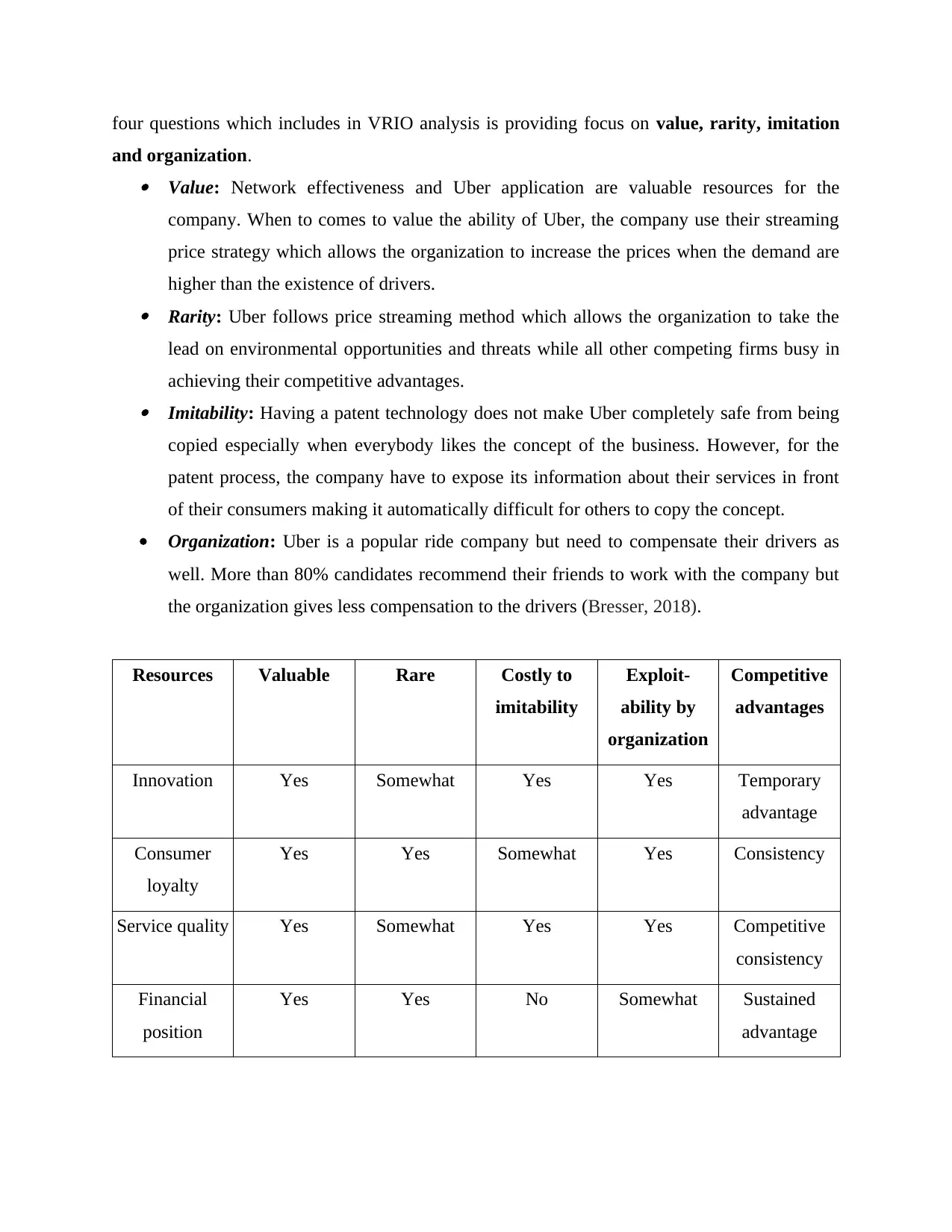
four questions which includes in VRIO analysis is providing focus on value, rarity, imitation
and organization. Value: Network effectiveness and Uber application are valuable resources for the
company. When to comes to value the ability of Uber, the company use their streaming
price strategy which allows the organization to increase the prices when the demand are
higher than the existence of drivers. Rarity: Uber follows price streaming method which allows the organization to take the
lead on environmental opportunities and threats while all other competing firms busy in
achieving their competitive advantages. Imitability: Having a patent technology does not make Uber completely safe from being
copied especially when everybody likes the concept of the business. However, for the
patent process, the company have to expose its information about their services in front
of their consumers making it automatically difficult for others to copy the concept.
Organization: Uber is a popular ride company but need to compensate their drivers as
well. More than 80% candidates recommend their friends to work with the company but
the organization gives less compensation to the drivers (Bresser, 2018).
Resources Valuable Rare Costly to
imitability
Exploit-
ability by
organization
Competitive
advantages
Innovation Yes Somewhat Yes Yes Temporary
advantage
Consumer
loyalty
Yes Yes Somewhat Yes Consistency
Service quality Yes Somewhat Yes Yes Competitive
consistency
Financial
position
Yes Yes No Somewhat Sustained
advantage
and organization. Value: Network effectiveness and Uber application are valuable resources for the
company. When to comes to value the ability of Uber, the company use their streaming
price strategy which allows the organization to increase the prices when the demand are
higher than the existence of drivers. Rarity: Uber follows price streaming method which allows the organization to take the
lead on environmental opportunities and threats while all other competing firms busy in
achieving their competitive advantages. Imitability: Having a patent technology does not make Uber completely safe from being
copied especially when everybody likes the concept of the business. However, for the
patent process, the company have to expose its information about their services in front
of their consumers making it automatically difficult for others to copy the concept.
Organization: Uber is a popular ride company but need to compensate their drivers as
well. More than 80% candidates recommend their friends to work with the company but
the organization gives less compensation to the drivers (Bresser, 2018).
Resources Valuable Rare Costly to
imitability
Exploit-
ability by
organization
Competitive
advantages
Innovation Yes Somewhat Yes Yes Temporary
advantage
Consumer
loyalty
Yes Yes Somewhat Yes Consistency
Service quality Yes Somewhat Yes Yes Competitive
consistency
Financial
position
Yes Yes No Somewhat Sustained
advantage
Paraphrase This Document
Need a fresh take? Get an instant paraphrase of this document with our AI Paraphraser
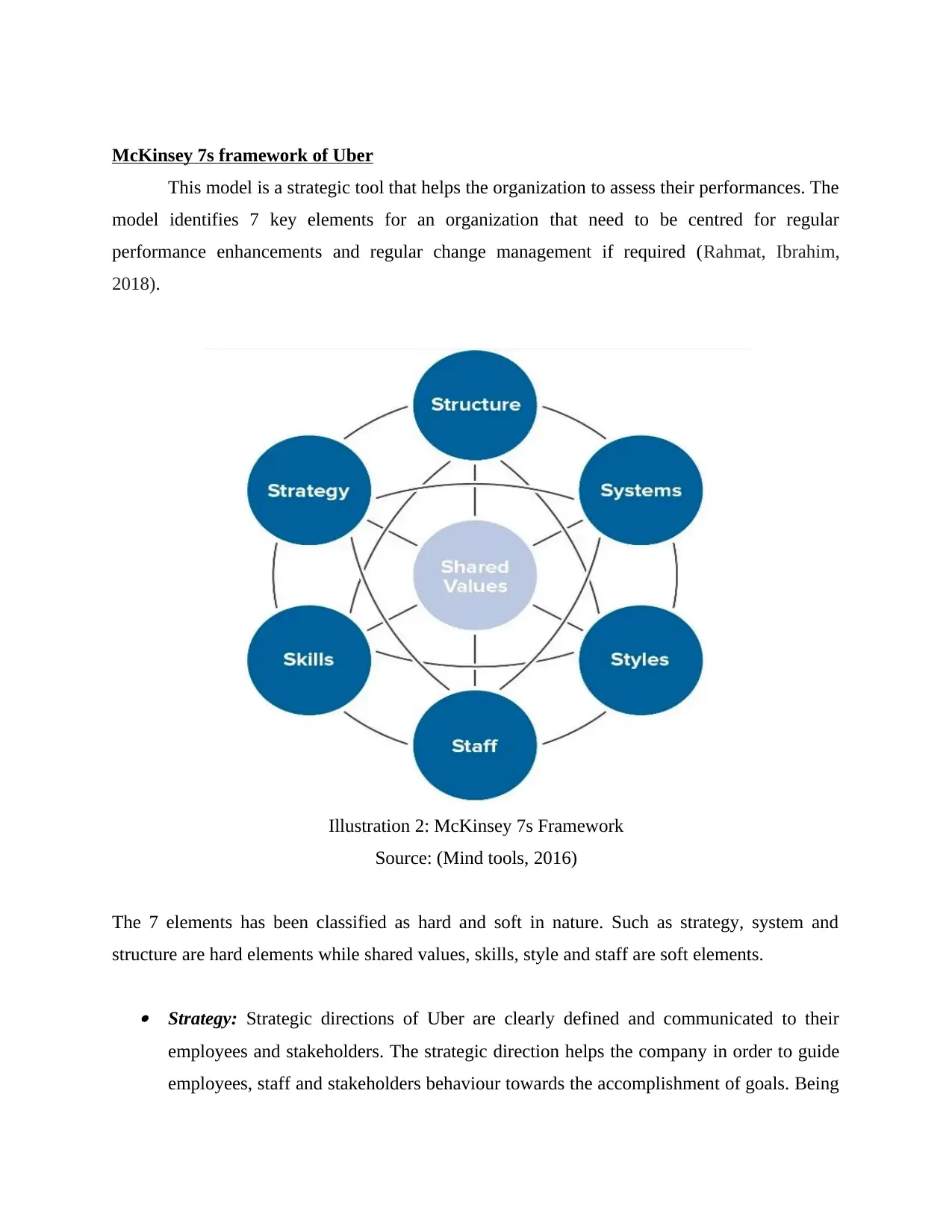
McKinsey 7s framework of Uber
This model is a strategic tool that helps the organization to assess their performances. The
model identifies 7 key elements for an organization that need to be centred for regular
performance enhancements and regular change management if required (Rahmat, Ibrahim,
2018).
The 7 elements has been classified as hard and soft in nature. Such as strategy, system and
structure are hard elements while shared values, skills, style and staff are soft elements.
Strategy: Strategic directions of Uber are clearly defined and communicated to their
employees and stakeholders. The strategic direction helps the company in order to guide
employees, staff and stakeholders behaviour towards the accomplishment of goals. Being
Illustration 2: McKinsey 7s Framework
Source: (Mind tools, 2016)
This model is a strategic tool that helps the organization to assess their performances. The
model identifies 7 key elements for an organization that need to be centred for regular
performance enhancements and regular change management if required (Rahmat, Ibrahim,
2018).
The 7 elements has been classified as hard and soft in nature. Such as strategy, system and
structure are hard elements while shared values, skills, style and staff are soft elements.
Strategy: Strategic directions of Uber are clearly defined and communicated to their
employees and stakeholders. The strategic direction helps the company in order to guide
employees, staff and stakeholders behaviour towards the accomplishment of goals. Being
Illustration 2: McKinsey 7s Framework
Source: (Mind tools, 2016)
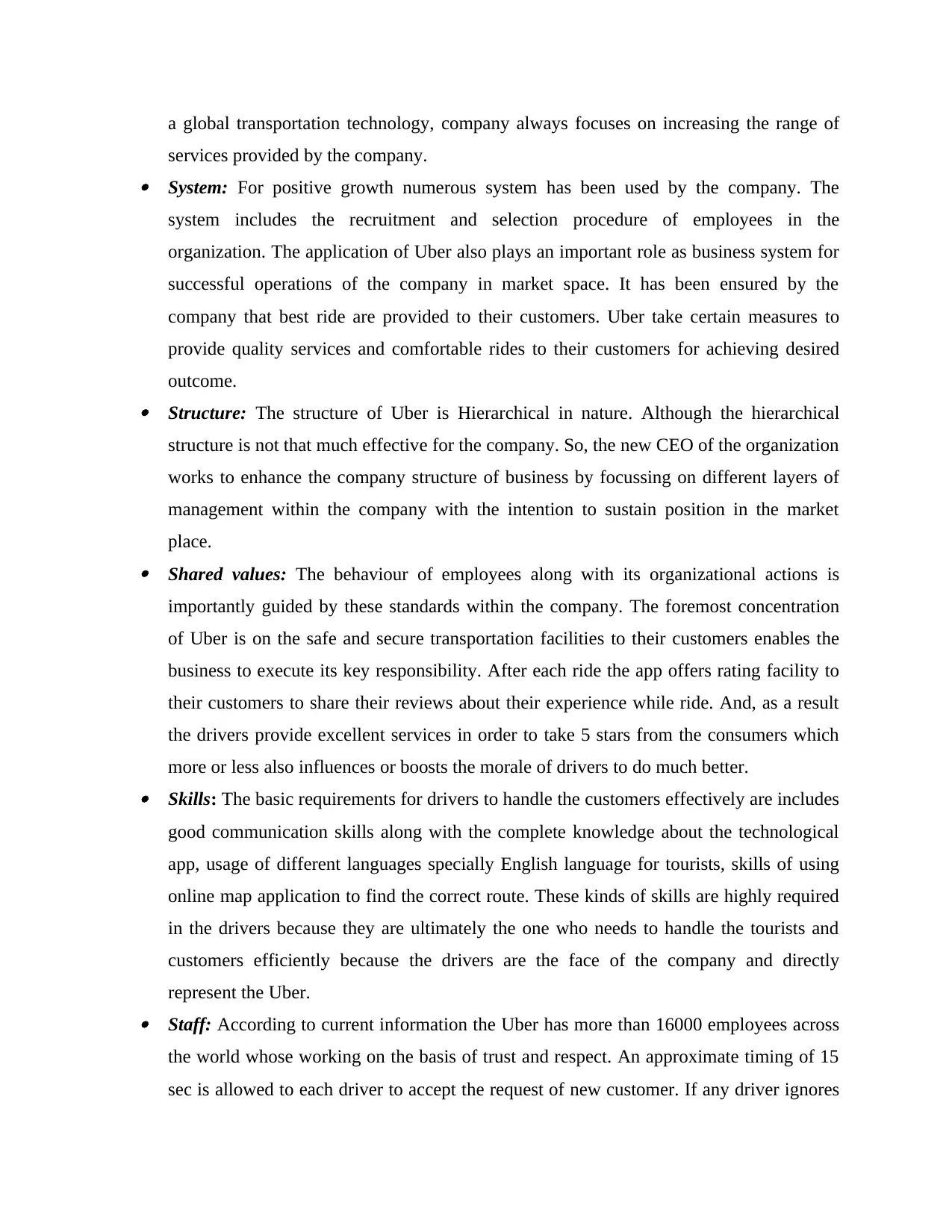
a global transportation technology, company always focuses on increasing the range of
services provided by the company. System: For positive growth numerous system has been used by the company. The
system includes the recruitment and selection procedure of employees in the
organization. The application of Uber also plays an important role as business system for
successful operations of the company in market space. It has been ensured by the
company that best ride are provided to their customers. Uber take certain measures to
provide quality services and comfortable rides to their customers for achieving desired
outcome. Structure: The structure of Uber is Hierarchical in nature. Although the hierarchical
structure is not that much effective for the company. So, the new CEO of the organization
works to enhance the company structure of business by focussing on different layers of
management within the company with the intention to sustain position in the market
place. Shared values: The behaviour of employees along with its organizational actions is
importantly guided by these standards within the company. The foremost concentration
of Uber is on the safe and secure transportation facilities to their customers enables the
business to execute its key responsibility. After each ride the app offers rating facility to
their customers to share their reviews about their experience while ride. And, as a result
the drivers provide excellent services in order to take 5 stars from the consumers which
more or less also influences or boosts the morale of drivers to do much better. Skills: The basic requirements for drivers to handle the customers effectively are includes
good communication skills along with the complete knowledge about the technological
app, usage of different languages specially English language for tourists, skills of using
online map application to find the correct route. These kinds of skills are highly required
in the drivers because they are ultimately the one who needs to handle the tourists and
customers efficiently because the drivers are the face of the company and directly
represent the Uber. Staff: According to current information the Uber has more than 16000 employees across
the world whose working on the basis of trust and respect. An approximate timing of 15
sec is allowed to each driver to accept the request of new customer. If any driver ignores
services provided by the company. System: For positive growth numerous system has been used by the company. The
system includes the recruitment and selection procedure of employees in the
organization. The application of Uber also plays an important role as business system for
successful operations of the company in market space. It has been ensured by the
company that best ride are provided to their customers. Uber take certain measures to
provide quality services and comfortable rides to their customers for achieving desired
outcome. Structure: The structure of Uber is Hierarchical in nature. Although the hierarchical
structure is not that much effective for the company. So, the new CEO of the organization
works to enhance the company structure of business by focussing on different layers of
management within the company with the intention to sustain position in the market
place. Shared values: The behaviour of employees along with its organizational actions is
importantly guided by these standards within the company. The foremost concentration
of Uber is on the safe and secure transportation facilities to their customers enables the
business to execute its key responsibility. After each ride the app offers rating facility to
their customers to share their reviews about their experience while ride. And, as a result
the drivers provide excellent services in order to take 5 stars from the consumers which
more or less also influences or boosts the morale of drivers to do much better. Skills: The basic requirements for drivers to handle the customers effectively are includes
good communication skills along with the complete knowledge about the technological
app, usage of different languages specially English language for tourists, skills of using
online map application to find the correct route. These kinds of skills are highly required
in the drivers because they are ultimately the one who needs to handle the tourists and
customers efficiently because the drivers are the face of the company and directly
represent the Uber. Staff: According to current information the Uber has more than 16000 employees across
the world whose working on the basis of trust and respect. An approximate timing of 15
sec is allowed to each driver to accept the request of new customer. If any driver ignores
⊘ This is a preview!⊘
Do you want full access?
Subscribe today to unlock all pages.

Trusted by 1+ million students worldwide
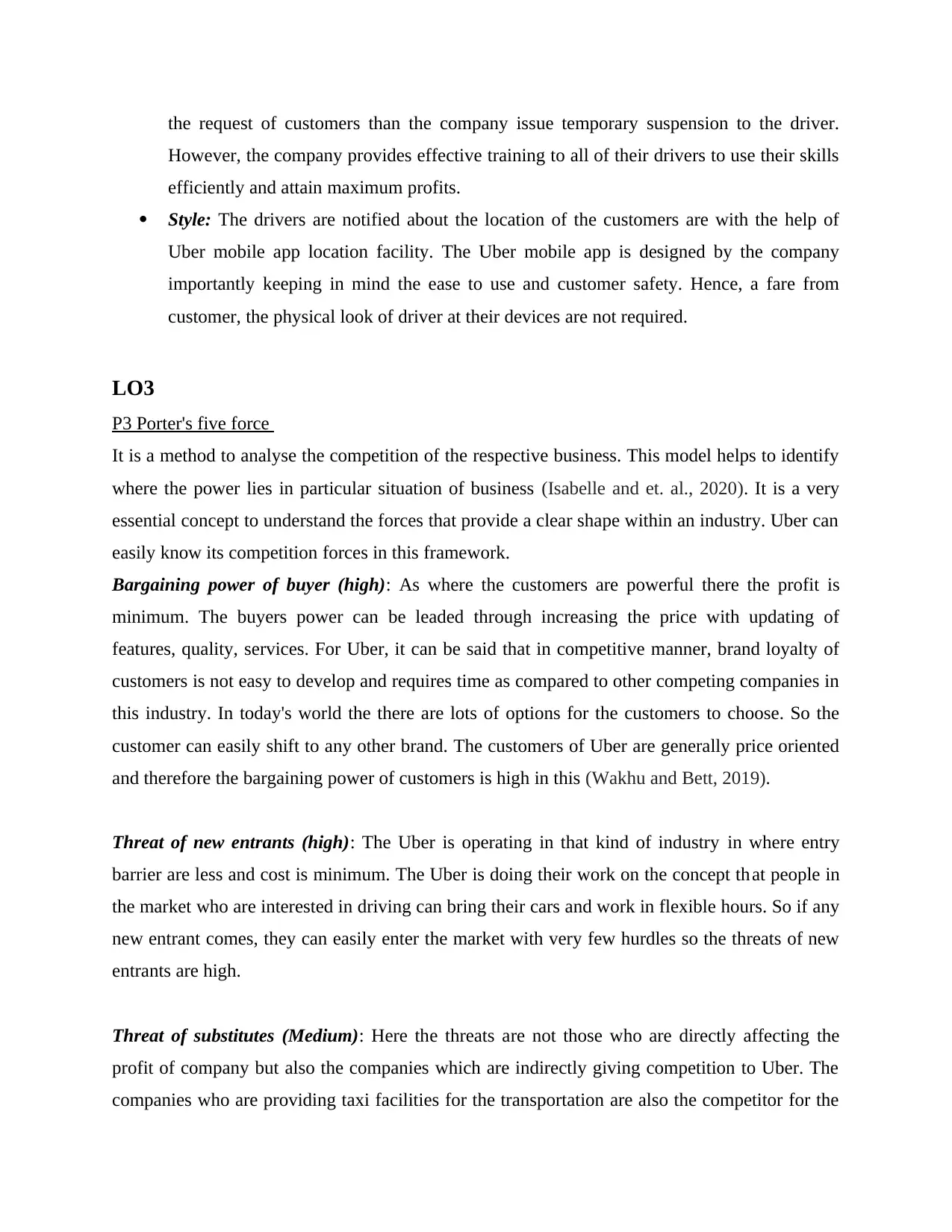
the request of customers than the company issue temporary suspension to the driver.
However, the company provides effective training to all of their drivers to use their skills
efficiently and attain maximum profits.
Style: The drivers are notified about the location of the customers are with the help of
Uber mobile app location facility. The Uber mobile app is designed by the company
importantly keeping in mind the ease to use and customer safety. Hence, a fare from
customer, the physical look of driver at their devices are not required.
LO3
P3 Porter's five force
It is a method to analyse the competition of the respective business. This model helps to identify
where the power lies in particular situation of business (Isabelle and et. al., 2020). It is a very
essential concept to understand the forces that provide a clear shape within an industry. Uber can
easily know its competition forces in this framework.
Bargaining power of buyer (high): As where the customers are powerful there the profit is
minimum. The buyers power can be leaded through increasing the price with updating of
features, quality, services. For Uber, it can be said that in competitive manner, brand loyalty of
customers is not easy to develop and requires time as compared to other competing companies in
this industry. In today's world the there are lots of options for the customers to choose. So the
customer can easily shift to any other brand. The customers of Uber are generally price oriented
and therefore the bargaining power of customers is high in this (Wakhu and Bett, 2019).
Threat of new entrants (high): The Uber is operating in that kind of industry in where entry
barrier are less and cost is minimum. The Uber is doing their work on the concept th at people in
the market who are interested in driving can bring their cars and work in flexible hours. So if any
new entrant comes, they can easily enter the market with very few hurdles so the threats of new
entrants are high.
Threat of substitutes (Medium): Here the threats are not those who are directly affecting the
profit of company but also the companies which are indirectly giving competition to Uber. The
companies who are providing taxi facilities for the transportation are also the competitor for the
However, the company provides effective training to all of their drivers to use their skills
efficiently and attain maximum profits.
Style: The drivers are notified about the location of the customers are with the help of
Uber mobile app location facility. The Uber mobile app is designed by the company
importantly keeping in mind the ease to use and customer safety. Hence, a fare from
customer, the physical look of driver at their devices are not required.
LO3
P3 Porter's five force
It is a method to analyse the competition of the respective business. This model helps to identify
where the power lies in particular situation of business (Isabelle and et. al., 2020). It is a very
essential concept to understand the forces that provide a clear shape within an industry. Uber can
easily know its competition forces in this framework.
Bargaining power of buyer (high): As where the customers are powerful there the profit is
minimum. The buyers power can be leaded through increasing the price with updating of
features, quality, services. For Uber, it can be said that in competitive manner, brand loyalty of
customers is not easy to develop and requires time as compared to other competing companies in
this industry. In today's world the there are lots of options for the customers to choose. So the
customer can easily shift to any other brand. The customers of Uber are generally price oriented
and therefore the bargaining power of customers is high in this (Wakhu and Bett, 2019).
Threat of new entrants (high): The Uber is operating in that kind of industry in where entry
barrier are less and cost is minimum. The Uber is doing their work on the concept th at people in
the market who are interested in driving can bring their cars and work in flexible hours. So if any
new entrant comes, they can easily enter the market with very few hurdles so the threats of new
entrants are high.
Threat of substitutes (Medium): Here the threats are not those who are directly affecting the
profit of company but also the companies which are indirectly giving competition to Uber. The
companies who are providing taxi facilities for the transportation are also the competitor for the
Paraphrase This Document
Need a fresh take? Get an instant paraphrase of this document with our AI Paraphraser
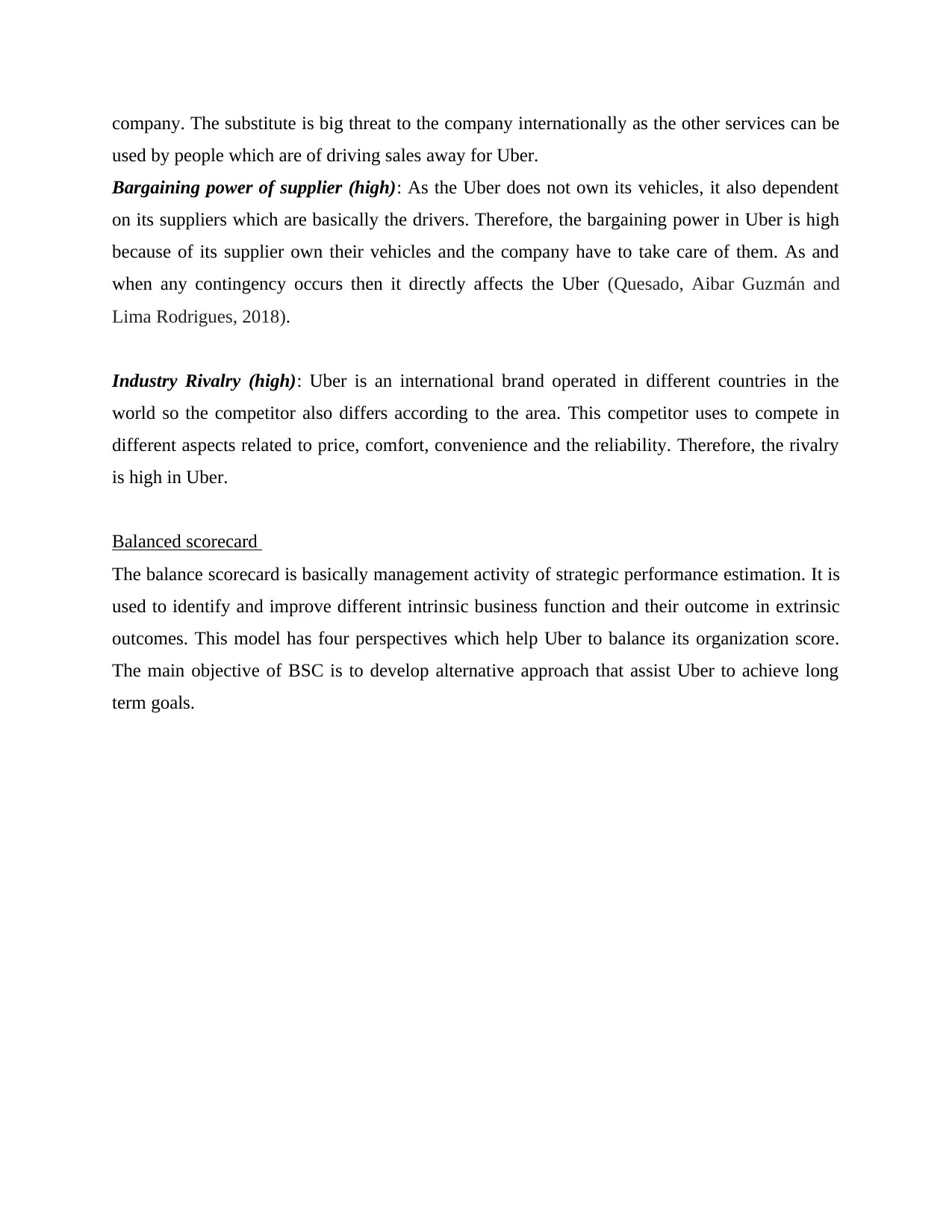
company. The substitute is big threat to the company internationally as the other services can be
used by people which are of driving sales away for Uber.
Bargaining power of supplier (high): As the Uber does not own its vehicles, it also dependent
on its suppliers which are basically the drivers. Therefore, the bargaining power in Uber is high
because of its supplier own their vehicles and the company have to take care of them. As and
when any contingency occurs then it directly affects the Uber (Quesado, Aibar Guzmán and
Lima Rodrigues, 2018).
Industry Rivalry (high): Uber is an international brand operated in different countries in the
world so the competitor also differs according to the area. This competitor uses to compete in
different aspects related to price, comfort, convenience and the reliability. Therefore, the rivalry
is high in Uber.
Balanced scorecard
The balance scorecard is basically management activity of strategic performance estimation. It is
used to identify and improve different intrinsic business function and their outcome in extrinsic
outcomes. This model has four perspectives which help Uber to balance its organization score.
The main objective of BSC is to develop alternative approach that assist Uber to achieve long
term goals.
used by people which are of driving sales away for Uber.
Bargaining power of supplier (high): As the Uber does not own its vehicles, it also dependent
on its suppliers which are basically the drivers. Therefore, the bargaining power in Uber is high
because of its supplier own their vehicles and the company have to take care of them. As and
when any contingency occurs then it directly affects the Uber (Quesado, Aibar Guzmán and
Lima Rodrigues, 2018).
Industry Rivalry (high): Uber is an international brand operated in different countries in the
world so the competitor also differs according to the area. This competitor uses to compete in
different aspects related to price, comfort, convenience and the reliability. Therefore, the rivalry
is high in Uber.
Balanced scorecard
The balance scorecard is basically management activity of strategic performance estimation. It is
used to identify and improve different intrinsic business function and their outcome in extrinsic
outcomes. This model has four perspectives which help Uber to balance its organization score.
The main objective of BSC is to develop alternative approach that assist Uber to achieve long
term goals.
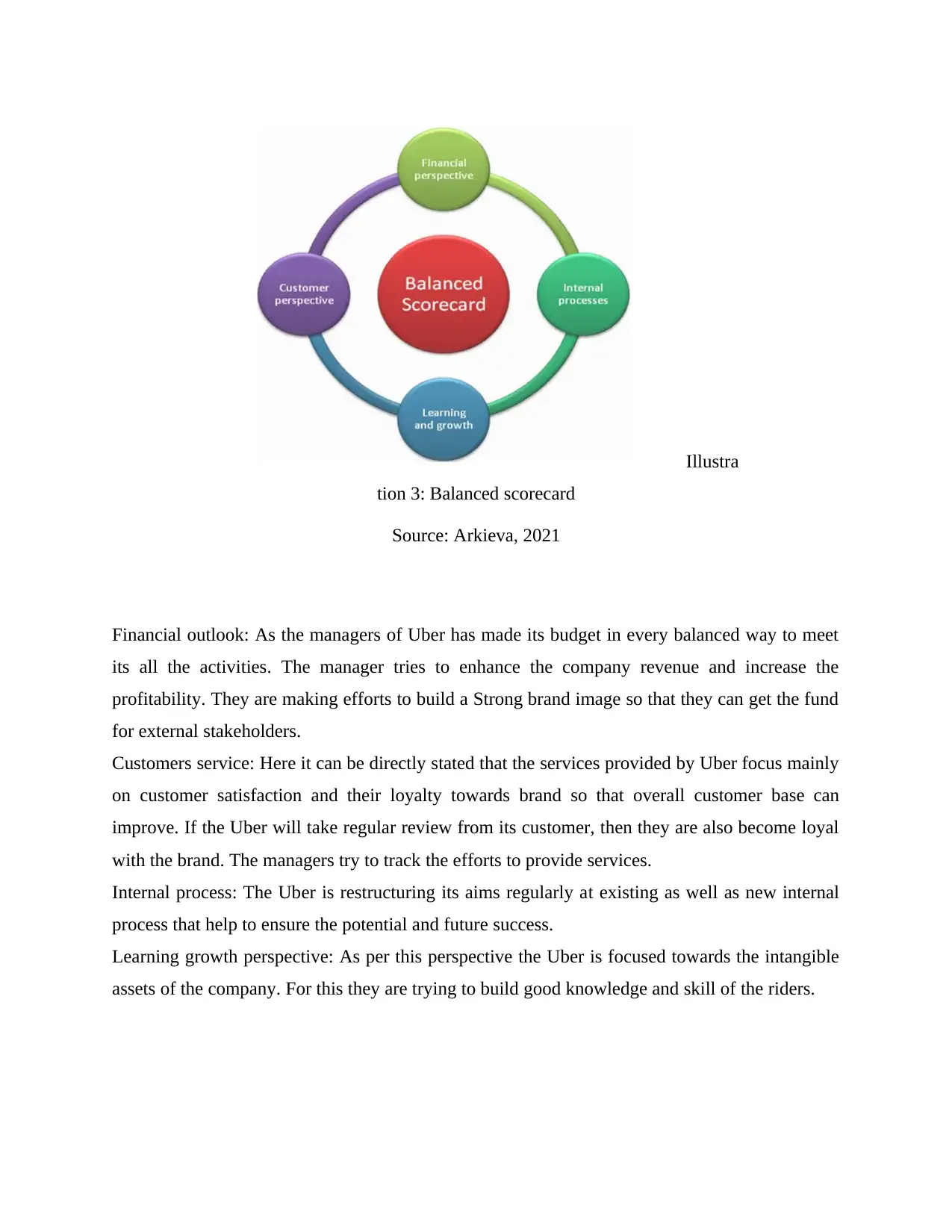
Financial outlook: As the managers of Uber has made its budget in every balanced way to meet
its all the activities. The manager tries to enhance the company revenue and increase the
profitability. They are making efforts to build a Strong brand image so that they can get the fund
for external stakeholders.
Customers service: Here it can be directly stated that the services provided by Uber focus mainly
on customer satisfaction and their loyalty towards brand so that overall customer base can
improve. If the Uber will take regular review from its customer, then they are also become loyal
with the brand. The managers try to track the efforts to provide services.
Internal process: The Uber is restructuring its aims regularly at existing as well as new internal
process that help to ensure the potential and future success.
Learning growth perspective: As per this perspective the Uber is focused towards the intangible
assets of the company. For this they are trying to build good knowledge and skill of the riders.
Illustra
tion 3: Balanced scorecard
Source: Arkieva, 2021
its all the activities. The manager tries to enhance the company revenue and increase the
profitability. They are making efforts to build a Strong brand image so that they can get the fund
for external stakeholders.
Customers service: Here it can be directly stated that the services provided by Uber focus mainly
on customer satisfaction and their loyalty towards brand so that overall customer base can
improve. If the Uber will take regular review from its customer, then they are also become loyal
with the brand. The managers try to track the efforts to provide services.
Internal process: The Uber is restructuring its aims regularly at existing as well as new internal
process that help to ensure the potential and future success.
Learning growth perspective: As per this perspective the Uber is focused towards the intangible
assets of the company. For this they are trying to build good knowledge and skill of the riders.
Illustra
tion 3: Balanced scorecard
Source: Arkieva, 2021
⊘ This is a preview!⊘
Do you want full access?
Subscribe today to unlock all pages.

Trusted by 1+ million students worldwide
1 out of 17
Related Documents
Your All-in-One AI-Powered Toolkit for Academic Success.
+13062052269
info@desklib.com
Available 24*7 on WhatsApp / Email
![[object Object]](/_next/static/media/star-bottom.7253800d.svg)
Unlock your academic potential
Copyright © 2020–2025 A2Z Services. All Rights Reserved. Developed and managed by ZUCOL.





